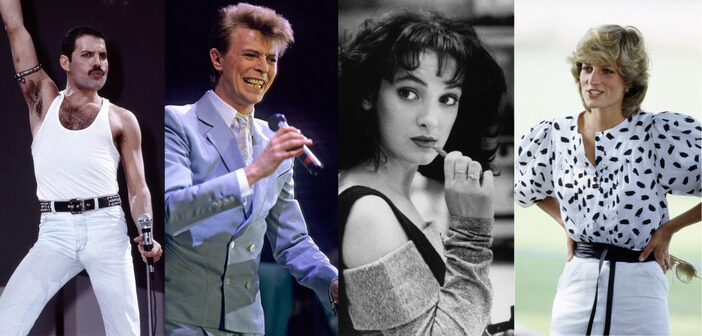The Eighties produced some incredible icons in fashion, music, movies, and more! Here’s the people who made the decade so memorable.
David Bowie
David Bowie was a well-established musical phenomenon in the 80s, with many of his greatest albums being released in the previous decade. Bowie had already been through numerous re-inventions of himself, such as Ziggy Stardust, Aladdin Sane, and The Thin White Duke. These alter egos consolidated him as an electrifying performer whose music was about more than the notes the band plays or the lyrics; it was about art.
Bowie’s first single of the 80s was ‘Ashes to Ashes’ from his fourteenth studio album, Scary Monsters (and Super Creeps). Bowie had the classic Rockstar experience during the ’70s; a drug addiction, which he sings about in the art rock/pop tune. He writes “we know Major Tom’s a junkie / strung out in heaven’s high, hitting an all-time low”, referencing his character from the 1969 hit ‘Space Oddity’. This melancholy song marks the more introspective path Bowie took in the ’80s.
Before the creative slump set in for Bowie, he released his biggest commercial song, ‘Let’s Dance’, in 1983, which became one of his fastest-selling singles. Everyone loved it, except for Bowie. The artist said he regretted the recording because it locked him in the mainstream box, and he was no longer a cult artist.
Acting became higher on Bowie’s to-do list. He starred in the 1986 fantasy, Labyrinth, playing the antagonist Goblin King, Jareth. Fans often applaud the role, despite the creepily sexual subtext of the film.
Bowie still appeared in a scattering of movies over his career, but he turned back to music, forming the Rock band Tin Machine in 1988. Tin Machine revitalised Bowie’s love for music after the rocky decade, and he also grew a beard!
The ’80s signified a turning point for Bowie as he struggled to come to terms with his mainstream popularity, but he still managed to release big hits such as ‘Under Pressure’ with Queen and ‘Dancing in the Street’ with Mick Jagger. Although Bowie struggled internally, his image never faltered, and in the next three decades, Bowie released 17 more albums.
David Bowie died on the 10th of January 2016, leaving behind an inspirational legacy of expressionism, creativity, and the lesson to always be yourself!
By Amy Scott-Munden
Diana
From the charities she worked with to the statement fashion choices to the taboo subjects she brought into the spotlight, Princess Diana’s legacy continues to live on 25 years after her death. With Netflix shows such as The Crown, this generation is well aware of the dramas surrounding her life and the infamous ways in which she held her head up high afterwards. *The black silk body-con dress has entered the chat*. However, what may be little well known to the next generation is the wonderful impact Diana had to so many people’s lives. Her ‘scandalous behaviours’ may have rocked the royal boat but in Diana’s time as a member of the royal family (and after) she had managed to break the stigma surrounding AIDS by shaking the hands of patients suffering from the illness. Furthermore, doing this without wearing gloves at a time when AIDS sufferers were ostracised, with society believing that you could catch the illness through touch. As well as this, through tours around the world, she brought attention to global issues. Knowing that something as simple as her presence would capture significant attention, Diana ventured to Angola in 1997 where active landmines lay underground. She walked across this site with the aim to bring attention to the issue and ban mines.
As much as this work, and many more global challenges she worked to change, had a hugely positive impact, it was internal struggles that Diana had yet to shine a light on. It was after her passing that sons Prince Harry and William and daughter-in-law Kate set up a mental health initiative in her honour, named Heads Together. What was once a taboo subject and something Diana suffered from is now globally recognised with initiatives like these changing the conversation surrounding mental health. Let’s hope that Diana’s legacy lives on and encourages people to break through barriers.
By Rosie Spurrier
Winona Ryder
You may know Winona Ryder as one of TV’s favourite dysfunctional mums in a little TV show called Stranger Things. Ironically, while Stranger Things tries to hark back to a nostalgic depiction of the 80s, Winona Ryder’s presence in the series feels a little ironic, especially when she was an 80s icon in her own right.
After almost 4o years in the business, Winona Ryder started her career in the 1986 film, Lucas. However, it wouldn’t be until the 1988 Tim Burton classic, Beetlejuice, that Winona Ryder would shoot to fame. Playing everyone’s second favourite goth (falling just short of number one to none other than Wednesday Addams), Winona Ryder brought a delicious slice of morbid curiosity to Beetlejuice as Lydia, even given Michael Keaton’s titular character, Beetlejuice, a running for his money. A match made in heaven.
It doesn’t stop there though.
Flash forward only a short while later in 1988 and suddenly Winona Ryder is gracing 80s film screens all over again, this time ditching the dark blacks of gothic drab, for… well… another dark comedy with a splash more colour – Heathers. Two classics in the same year… no wonder Winona Ryder is remembered so fondly as a huge part of the 80s. Now include the filmography that goes on to include classics like Edward Scissorhands, Bram Stocker’s Dracula, Girl Interrupted, etc. (the list really goes on), and it’s not hard to see why Winona Ryder’s career has been one of Hollywood’s most memorable and enduring.
By Sam Pegg
Freddie Mercury
Freddie Mercury: a name that carries an incredible legacy in the history of pop culture. With his unwavering talent and undeniable charisma, the late legend dominated decades of popular culture, however, he did so especially during the 1980s, a time when his band Queen were at the peak of their careers and stardom. Throughout this decade we have an abundance of flamboyant fashion moments to fawn over, so why not look at the fashion legacy of arguably the most flamboyant star there has ever been!
Freddie Mercury’s style seems to have been in a permanent state of fluctuation and reinvention, and it’s because of this that I find him so admirable. His style was able to encompass both womenswear and menswear allowing it to have even more longevity than the styles we’ve seen produced over the 4 decades. Whether his outfit would be seen as more for men or for women would not change the fact that his outfits were almost always tight. We often see Freddie in an outfit synonymous with his legendary image, a very low-cut, white spandex unitard. We can see clear reiterations of this iconic look in more modern designs, for example, the Vivienne Westwood unitard from Spring/Summer 2019.
One of his most iconic looks was the variety of military jackets he’d wear. We have seen this paid homage to many times in more comical ways through a variety of Halloween costumes. However, the style has also been reinterpreted for high fashion, although I’d argue in a much less flamboyant way. The most famous military jacket he wore was a yellow leather jacket worn in a performance at Wembley in 1986. I feel the jackets don’t invoke a feeling of the military when worn by Freddie. Instead, he feels and looks much more like a superhero; our Supersonic Man.
By Megan Eynon – Daly
Kate Bush
The 80’s musical icon that has been renewed and retold due to the popularity that shrouds the ever-growing TV show, Stranger Things, the first-ever female artist to produce a UK Number One with a self-written song, and whose experimental nature leaves a lasting impact on listeners and music as we know it today, is of course, Kate Bush. Kate Bush is not only an 80s icon in her own right, but her musical legacy is certainly one of relevancy today. Being the first British female solo artist to top the UK album charts, as well as being the first female to enter at number one, her success is more than evident, setting a new precedent for feminine roles in the mainstream music sphere. This, combined with her eclectic aesthetics and style makes for incredibly memorable hits such as ‘Babooshka’ and ‘The Man with the Child in his Eyes,’ (written at just 13 years old!). Both ‘Babooshka,’ and ‘Running Up That Hill,’ have faced a huge re-emergence in popular culture today. Of course, Stranger Things shot ‘Running Up That Hill,’ straight back into the charts, introducing the new generation to the marvel that is Bush, while also stirring up some reminiscence for those who experienced the 8os in real-time. ‘Babooshka,’, as avid TikTok users would know, found new-age popularity on the app and has taken the social media platform by storm.
Bush’s genius lyrical power, then, is iconic in and of itself; a new age of lyrical art, one that remains relevant even in today’s over-saturated pop culture. With Kate Bush’s musical diversity and unconventionality, it is no surprise she won ‘Best British Female Artist’, in 1987. Truly, Kate Bush made music that fit into many genres, played around with gothic and glam-rock aesthetics, and was nothing short of art. Rightfully so, Kate Bush has been hailed as ‘the queen of art-pop,’ whose legacy as an iconic 80’s female artist continues on feverishly, inspiring pop-culture and then some tirelessly.
By Emily Poole
Cyndi Lauper
Cyndi Lauper, well known for iconic hits such as ‘Time After Time,’ and ‘Girls Just Wanna Have Fun,’ is certainly an 80’s artist that cannot be forgotten. Lauper did not only revolutionise the feminine body and aesthetic in the worlds of Pop and Rock with her music but also introduced new popularity of punk fashion and feminine edginess into the landscape of popular culture. ‘Girls Just Wanna Have Fun,’, in particular, becomes a feminist anthem which encouraged playfulness and warmth into the aspect of womanhood and the musical culture of the 80s.
Despite being inducted into the Songwriters Hall of Fame, it was not just Lauper’s artistic ability that fulfils her role as an icon and keeps her legacy ongoing. Lauper was an activist in her own right, aside from her iconic and distinctive image, Lauper actively advocated for LGBTQ+ rights, in a time of prejudice and uncertainty- citing her openly gay sister, Ellen as her role model. Beautifully, Lauper used her musical influence to further support this; ‘True Colours’ is known as a gay anthem, and ‘Above The Clouds,’ is a memoir for Matthew Shepard.
In fact, Lauper was recognised for her humanitarian efforts, being specially invited to Barack Obama’s second inauguration in 2013. As an artist and an activist, Cyndi Lauper is most definitely a beloved 80s icon to be celebrated, her music certainly remaining popular today and her legacy being filled with acceptance, equality and genuine goodness. With her eccentric style, and playful loving attitude it is no surprise she becomes a beloved musical icon, but also fulfils an incredibly important, and still relevant legacy, even today.
By Emily Poole




